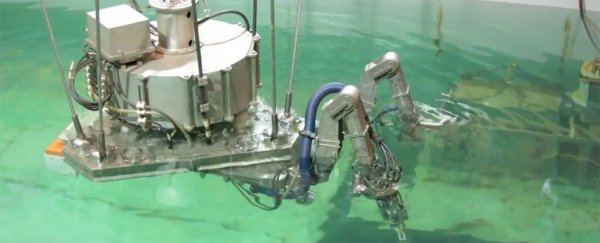It's been almost five years since the nuclear disaster at the Fukushima Daiichi Nuclear Power Plant in 2011, but the scale of the emergency means Japan is still at the relative beginning of efforts to clean up and contain the radioactive site.
So this week Toshiba unveiled a remote-control robot that's expected to remove fuel-rod assemblies from the spent fuel pool in the plant's reactor 3 building, according to a report by Kazuaki Nagata at The Japan Times.
Tokyo Electric Power Company (Tepco), the Japanese utility that maintains the site, has acknowledged that the high level of radiation in the reactor 3 building means it's impossible for humans to safely remove the fuel-rod assemblies. Because of this, a device like the robotic crane – which you can see in action in the video below – is necessary.
Specially designed by Toshiba – the original supplier of Fukushima's reactor 3 and reactor 5 decades ago – the machine features robotic arms that can be used to manipulate and dismantle debris, and to retrieve rods from the reactor cooling pool.
It will be lowered into the pool by a crane, and controlled by human operators working at a safe distance. It's fitted out with numerous cameras that let the robot's operators see its immediate surroundings.
The work, which is expected to begin next year, is a big endeavour, with 566 fuel-rod assemblies that need to be removed from just this one reactor. In 2014, Tepco successfully removed 1,535 spent fuel-rod assemblies from the pool in the reactor 4 building. While that number was higher, the task was also significantly easier, as lower radiation levels meant human workers could oversee the retrievals more closely. In reactor 3, that's not an option.
Efforts to clean up Fukushima, which is considered the largest nuclear disaster since the Chernobyl accident in 1986, are under continued scrutiny after a series of blunders and Tepco's admission that efforts in the short term to contain contamination may take as long as 30–40 years.
Of major concern is the leakage of water from the site, with signs of Fukushima contaminants having been discovered as far away as the west coast of the US – literally an entire ocean away from the disaster.
Within Japan, there are fears of ongoing health problems related to the accident, with researchers linking higher incidence of children's cancer to Fukushima radiation, the impact of which has also been seen on animals in the wild.
